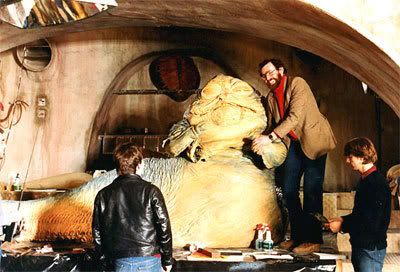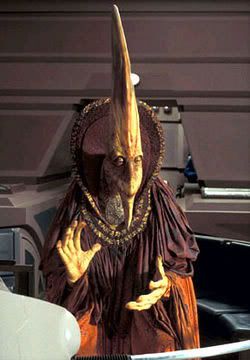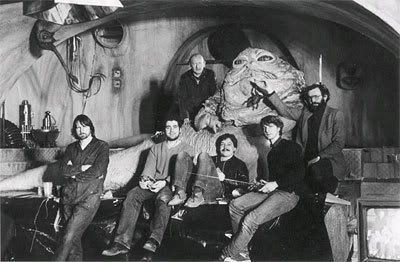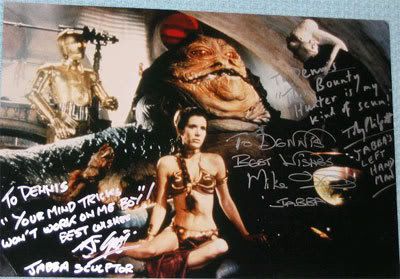When Jabba was created he was the most expensive creature ever built for a movie.
In 2006 I had the following interview with Jabba's sculptor John Coppinger, who also worked on some other wellknown movies like Harry Potter, the Fifth Element and Return to Oz.
The interview you are about to read premieres on this website after originally being published in Dutch for a Dutch Star Wars website.

What got you started into sculpting? Was it a movie, an experience or something else?
I started sculpting at school, with the encouragement of the art master there (Bob White), but that was mostly welded steel pieces with a few clay sculpts and some pottery. I preferred welding to studying history, which is what I should have been doing! Mr. White then helped me get a place at Maidstone Art College and I went on to study sculpture at St.Martins school of art in London. I got lucky again after that and worked for 8 years as a scientific model-maker at London’s' Natural History Museum. This was like a paid post-graduate course, where I could experiment with new materials and methods for sculpting and model-making.

What are you doing these days? Can you tell us something about your current or future projects?
I'm concentrating on writing now, something I've wanted to pursue for a long time. I have published my first novel Tertiary through Lulu.com. If you don't mind me promoting it, it's available at Amazon and most book stores: ISBN 1 - 4116 - 6160 - 5. The second novel Archive is underway. I still run a small company Life Form, with my partner Nicole (her new website is www.eeriebeauty.com ), and we do work for films, TV and Museums. We've made models for the Royal Institution Christmas lectures for the last three years and hope to do that again. It's a great mix of theatre and live TV, with 300 kids in a 19th century lecture hall, and fits our interest in linking Science and Art.
You are one of the few crewmembers that were involved with Return of the Jedi back in 1983 and Episode I sixteen years later, in 1999. Did you keep in touch with George Lucas all these years and how did you get approached for both movies?
I didn't keep in touch with George Lucas, I was just one of several hundred technicians on Return of the Jedi, but I did keep in contact with Stuart Freeborn. I had asked Stuart for an interview, when I found out he was make-up chief in the UK for Return of the Jedi, and he gave me the job of sculpting Jabba. I also met Nick Dudman, who was just starting his make-up career then. Nick became a crew boss, and he asked me to work on Episode I sixteen years later. I'd already worked for him on The Fifth Element not long before that.

You stood in for Silas Carson as Ki-Adi-Mundi in one scene. Can you tell us which scene that was?
It was a very brief scene, at the end of the film, when the Jedi Council arrives in the Main Plaza of Theed, and is walking down the ramp of a starship. Silas was playing another character in that scene, Nute Gunray, so obviously couldn't be two people at once. Kate Murray had designed and sculpted the prosthetic make-up for Ki-Adi-Mundi, using a life-cast of Silas. She did an amazing job of making the character fit on me, so much so that other performers thought I was Silas!
In Episode I you played a Wookiee senator. How did that feel, to perform as a character instead of sculpting characters?
It was great! Right from operating Jabba on set, with six to eight other people, I've enjoyed bringing the characters to life. But playing the Wookiee Senator was the first time I'd been in a full costume. It was even better, because Wookiees were always my favorite Star Wars Characters.
You sculpted Jabba the Hutt; one of the largest and most expensive animatronics ever. Nowadays it’s mostly CGI; large animatronics are less made. In 1997 for instance, a digital Jabba the Hutt was included in the special edition. What do you think about this Jabba compared with the one you made?
Very hard to be objective here, but there's no doubt the first CGI Jabba was awful. I actually think it was a brave attempt, given the state of CGI then, but I believe they tried to do too much. The subtleties of facial expression were really beyond CGI at that point, even on face as large as Jabba's! One aspect of 'our' Jabba was how many people it took to make him live. There were always at least three people operating his face from outside, not including David Barclay and Toby Philpott who were inside as puppeteers. They were moving his arms, his head, body, jaw and tongue. But despite that I think we co-coordinated a better result than CGI. And Jabba was really there for the other actors and performers to react and relate to.

You have worked with George Lucas twice; how would you describe him and did he change in the sixteen years between Return of the Jedi and Episode I?
I talked to him a couple of times on Return of the Jedi, about Jabba's color and character. He seemed a quiet and thoughtful person, really quite shy, but he obviously knew what he wanted. I hope he felt at home with us; animatronics people have never confused enthusiasm with being amateur and I believe George Lucas thinks the same way. I didn't talk to him directly on Episode I. The only time I met him I was eleven foot tall; demonstrating the prototype Anxx character! But I saw him on set and would say he had relaxed over the years, certainly the atmosphere was very nostalgic. It 'smelled' like Star Wars, if that makes sense.
Did you meet ‘the big 3’ (Mark Hamill, Carrie Fisher, Harrison Ford)?
What do you think of them? How were they on the set?
I don't remember talking to Mark Hamill on set, but Carrie Fisher was very easy to get on with, obviously loved working with Jabba and showed no sign of 'Star Syndrome'. The few times I've met and talked to stars on the set they've all been very friendly, they are just part of the crew even if they do earn a bit more than the rest of us. Harrison Ford did get annoyed with Jabba one day but he was repeatedly falling on his head at the time, out of the carbonite panel, and I guess he was just acting in character. It was a feature of Jabba that everyone, especially the director, talked to him as a person rather than to any one his crew. So he was believable as a real creature / character right from the start.
For The Dark Crystal you designed puppets. Can you tell us exactly which puppets you designed and how the process went?
I was in charge of the Environment Puppets. This covered anything that moved in the swamp set and a few creatures, like crystal spiders, on Aughra's mountain. For the swamp we made moving flowers, flying seeds, a giant swamp creature and a forty foot walking tree. Plus a lot of static plants to dress the set, and some 'rotten' versions for the Skeksis banquet scene.

Of all the characters, puppets and animatronics you didn’t make: which one would you like to remake?
Actually I would have liked to sculpt Jabba as a young man, sixteen years after I sculpted him for his death! But that wasn't to be. I think the CGI Hutts in Episode I were a great improvement on the special edition, but it was such a brief scene I can understand why they weren't made as puppets.
You wrote an essay about monsters that can be read on your website; what is it that fascinates you about them, and what is your all-time favorite monster?
In brief, I suppose it's the way we create monsters to embody our fears and make them a little easier to deal with them. In that sense they are our friends. My all time favorite monster is a very popular one; the face hugger and chest burster from Alien. Well, I guess the whole life cycle of the beast, from face hugger to full Alien.
What is your favorite scene of all the movies you have worked on?
I'll cheat and say two. The dancing scene in Jabba's palace and / or his death scene, and the entrance of the Diva in The Fifth Element. That actually makes three doesn't it, sorry!

Can you tell us something about your work regarding the Harry Potter movies?
To be honest I didn't do so much on those films, not in terms of 'headline' characters anyway. But I enjoyed sculpting the Unicorn for the first Harry Potter film, because Nick Dudman let us experiment and make a really believable creature. It had a fully articulated steel skeleton (made by Jim Sandys), the hair was flocked (team led by Esteban Mendoza) and the finished Unicorn was beautiful even if it did have to be dead.
You worked on Return to Oz; a great movie that never really got the appreciation it deserved. What were the animatronics you designed for that movie? And what is your own opinion about this movie?
As you say this is kind of a forgotten movie. And for me it was one of the best because I was working on it right from the start, making art department models of most of the main characters. Then I helped develop the look, and the full size rigs, of TikTok, the Wheelers and the Cowardly Lion amongst others. But I missed the filming; there was a break over Christmas and then the crew was re-hired. (In the meantime I'd accepted an offer to work for Malcolm Stone on Santa Claus. He was the art director in charge of making all the animatronic reindeer, also working with the animal trainers who looked after the real animals. That was a real challenge and I think we succeeded; there were times when people mistook our animatronic reindeer for the real thing, because they were livelier!) Going back to Return to Oz, I do think it was a good film. Largely because the director, Walter Murch, was so dedicated to the original stories.
Back to the main page
www.sangambayard-c-m.com
BeantwoordenVerwijderen